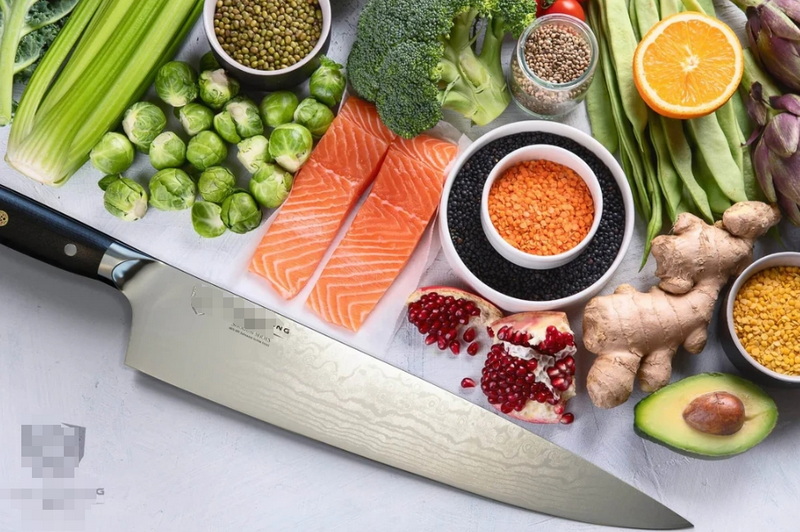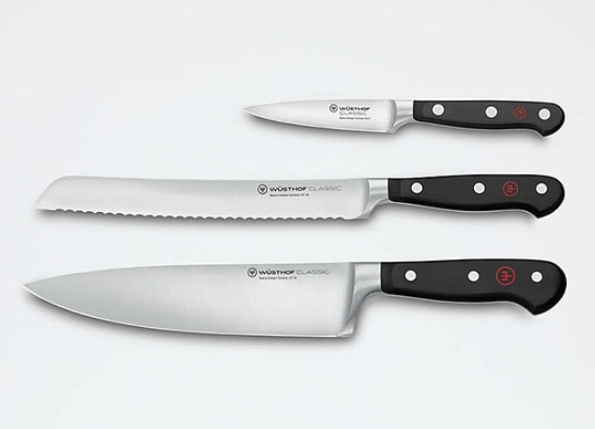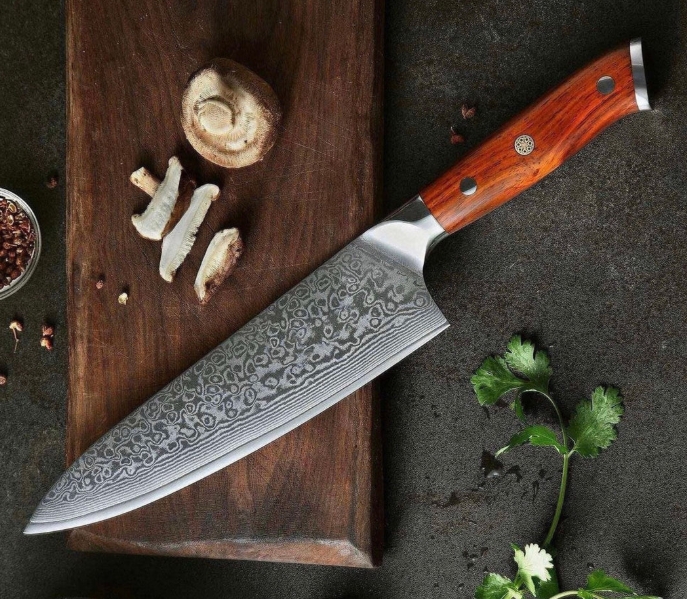

Views: 222 Author: Ella Publish Time: 2025-04-25 Origin: Site








Content Menu
● The Importance of Investing in a Good Kitchen Knife
>> Efficiency and Speed in Food Preparation
>> Enhanced Culinary Skills and Enjoyment
● How to Choose the Right Kitchen Knife
>> Blade Material and Construction
>> Handle Material and Ergonomics
● Caring for Your Kitchen Knife
● FAQ
>> 1. Why is a sharp knife safer than a dull one?
>> 2. How often should I sharpen my kitchen knife?
>> 3. What is the difference between forged and stamped knives?
>> 4. How do I maintain a carbon steel knife?
>> 5. What size chef's knife should I buy?
Investing in a good kitchen knife is one of the most impactful decisions you can make for your culinary journey. Whether you are a professional chef or a passionate home cook, the right knife can transform your cooking experience by enhancing efficiency, safety, precision, and enjoyment. This comprehensive article explores why a high-quality kitchen knife is worth the investment, how to choose the best one, how to care for it, and answers frequently asked questions about kitchen knives.

A high-quality kitchen knife allows you to prepare food faster and with less effort. Sharp blades cut through ingredients cleanly and smoothly, reducing the time and force needed for chopping, slicing, and dicing. For example, an 8-inch chef's knife can handle about 90% of kitchen cutting tasks, from vegetables to meats, making it a versatile and indispensable tool.
When you use a dull knife, you often have to saw back and forth, which not only slows you down but also crushes delicate ingredients like herbs or ripe tomatoes, causing them to lose their texture and flavor. A sharp knife glides through food effortlessly, preserving the integrity of your ingredients and speeding up meal prep significantly.
Contrary to popular belief, a sharp knife is safer than a dull one. Dull blades require more pressure, increasing the risk of slips and accidents. A sharp, well-balanced knife reduces hand fatigue and allows for more controlled cuts, minimizing injuries.
Using a good knife also encourages proper cutting techniques. For example, the "claw grip," where you tuck your fingertips inward and hold the food with your knuckles facing the blade, is easier and safer to perform with a knife that responds predictably. This grip protects your fingers and helps maintain control over the blade.
Good knives provide superior control, enabling precise cuts that enhance the texture and presentation of your dishes. Clean cuts preserve the integrity of ingredients, which can affect cooking time and flavor release. This precision is especially important for delicate tasks like filleting fish or finely chopping herbs.
For example, when slicing sashimi or preparing a fine julienne of vegetables, the sharpness and balance of the knife allow you to make thin, even slices that cook uniformly and look professional. Precision cutting also affects the taste; unevenly cut food can cook unevenly, leading to inconsistent flavors and textures.
High-quality knives are made from superior materials and craftsmanship, allowing them to maintain sharpness longer and withstand daily wear and tear. While the upfront cost may be higher, these knives often last a lifetime with proper care, ultimately saving money by reducing the need for frequent replacements.
Investing in a good knife means you won't have to constantly replace cheap, dull knives that chip or bend easily. Many premium knives come with warranties and can be professionally serviced, including sharpening and handle repairs, which extend their lifespan even further.
Using a good knife can improve your cooking skills by making cutting techniques easier to master and more enjoyable. The right knife feels like an extension of your hand, encouraging confidence and creativity in the kitchen.
Many chefs and cooking enthusiasts find that a quality knife inspires them to try new recipes and techniques because the preparation process becomes more satisfying. The tactile feedback, weight, and balance of a good knife can turn mundane tasks into a pleasurable ritual.
- Chef's Knife (French vs. Japanese)
The French chef's knife typically has a heavier, curved blade ideal for rocking motions, while the Japanese Santoku knife is lighter with a flatter blade suited for slicing, mincing, and chopping. Both are versatile, but your choice depends on your cutting style and preference.
- Paring Knife
Small and precise, paring knives are perfect for peeling, coring, and intricate work like decorative slicing.
- Specialty Knives
Other knives like boning, bread, and vegetable knives serve specific purposes and can complement your main knives.
Choosing the right knife depends on your cooking habits. If you often prepare large meals or work with tougher ingredients, a heavier, forged chef's knife might be ideal. For lighter, more delicate tasks, a Santoku or paring knife may be better suited.

- Steel Quality
Look for high-carbon stainless steel or laminated steel blades. Laminated blades combine a hard core for sharpness with a softer outer layer for durability and ease of sharpening.
- Blade Grind
Double-bevel blades are common in Western knives, suitable for both left- and right-handed users. Japanese knives often have a sharper, single-bevel edge for more precise cuts but require more care.
- Forged vs. Stamped
Forged knives are made from a single piece of steel and tend to be heavier and more durable. Stamped knives are lighter and more flexible, better for delicate tasks.
High-carbon stainless steel is particularly popular because it offers a good balance of sharpness, rust resistance, and ease of maintenance. Laminated blades, often found in Japanese knives, provide a razor-sharp edge with a tough, flexible body.
Handles can be made from wood, plastic, composite, or metal. Ergonomics is crucial for comfort and control. A well-balanced knife with a comfortable grip reduces hand fatigue and improves safety.
Wood handles provide a warm, traditional feel but require more maintenance to prevent cracking or warping. Synthetic handles like polypropylene or resin composites are durable, water-resistant, and easier to clean. Metal handles are sleek and durable but can be slippery or cold to the touch.
Most chefs prefer an 8-inch blade for versatility, but sizes from 6 to 12 inches are available. The knife should feel balanced and comfortable in your hand.
Weight preference varies by individual. Some cooks prefer a heavier knife that does more of the work with each cut, while others favor a lighter knife for speed and agility. The best way to choose is to hold different knives and see which feels right for your hand size and strength.
Proper care extends the life and performance of your knife:
- Cleaning
Always hand wash knives with warm, soapy water immediately after use and dry thoroughly to prevent rust and corrosion.
- Sharpening and Honing
Regular honing keeps the blade aligned, while sharpening with a whetstone or professional service restores the edge. Avoid machine sharpening, which can damage the blade.
- Storage
Store knives on magnetic strips, in knife rolls, or protective sheaths to protect edges and prevent accidents.
- Avoid Misuse
Do not use knives on hard surfaces like glass or granite, avoid cutting frozen foods or bones, and never use knives as tools for prying or opening cans.
- Special Care for Carbon Steel Knives
These require oiling after cleaning to prevent rust and patina formation, especially after cutting acidic foods.
Dishwashers are a no-go for quality knives because the high heat and detergents can damage the blade and handle. Always wash by hand and dry immediately. Avoid soaking knives in water, which can loosen the handle or cause rust spots.
Honing rods realign the microscopic teeth on the blade edge and should be used frequently—ideally before or after each use. Sharpening, which removes metal to create a new edge, should be done less often, depending on use—typically every few months.
Using a whetstone is the preferred method for sharpening because it allows you to control the angle and pressure. Professional sharpening services are also an excellent option for maintaining the best edge.
Proper storage prevents dulling and accidents. Magnetic strips keep knives accessible and visible but require careful placement to avoid chipping. Knife blocks protect edges but can harbor bacteria if not cleaned regularly. Sheaths and knife rolls are great for travel or storage in drawers.
Investing in a good kitchen knife is a decision that enhances your cooking efficiency, safety, precision, and enjoyment. High-quality knives offer durability, better control, and the ability to produce beautifully prepared dishes. While they may require a higher initial investment, their longevity and performance make them cost-effective over time. Proper care and maintenance ensure your knives remain sharp and reliable for years. Whether you are a novice or an experienced cook, a good kitchen knife is an indispensable tool that elevates your culinary experience.

A sharp knife requires less force to cut, reducing the chance of slipping and accidental cuts. Dull knives need more pressure, increasing the risk of injury.
Sharpening frequency depends on use, but generally, honing should be done regularly (every few uses), and sharpening with a whetstone or professional service a few times a year.
Forged knives are made from a single piece of steel, heavier and more durable. Stamped knives are cut from steel sheets, lighter and more flexible, suitable for delicate tasks.
Carbon steel knives should be washed and dried immediately after use, especially after cutting acidic foods, and oiled regularly to prevent rust and patina.
An 8-inch chef's knife is the most versatile and widely recommended size for most kitchen tasks. However, sizes from 6 to 12 inches are available depending on your preference and cutting style.
[1] https://yakushiknives.com/blogs/yakushi-blog-all-thing-knives/why-investing-in-a-good-knife-is-worth-it
[2] https://schoolofwok.co.uk/blog/show/why-you-need-good-quality-knives-in-your-kitchen
[3] https://www.butchersequipment.co.uk/blog/why-a-chef-knife-is-the-most-important-tool-in-the-kitchen/
[4] https://beardedbutchers.com/blogs/news/the-complete-kitchen-knife-buyers-guide
[5] https://www.istockphoto.com/photos/kitchen-knife
[6] https://www.youtube.com/watch?v=-al-bs737fw
[7] https://www.seriouseats.com/the-best-chefs-knives
[8] https://www.youtube.com/watch?v=FNuV7lg6jgg
[9] https://www.youtube.com/watch?v=NlnOsnr94qM
[10] https://sharpedgeshop.com/blogs/knives-101/how-to-choose-a-kitchen-knife
[11] https://artisanrevere.com/blogs/education/knife-faq-and-problem-solving
[12] https://www.johnlewis.com/buying-guides/kitchen-knives-buying-guide
[13] https://www.souschef.co.uk/blogs/the-bureau-of-taste/how-to-care-for-your-kitchen-knife
[14] https://towncutler.com/pages/care-and-maintenance
[15] https://www.thebambooguy.com/blogs/kitchen-knives/why-every-home-cook-should-invest-in-high-quality-knives
[16] https://www.reddit.com/r/Cooking/comments/s9p205/would_you_invest_in_an_expensive_knife_set/
[17] https://www.koiknives.com/blogs/japanese-knives/the-crucial-role-of-choosing-the-right-kitchen-knife-for-every-task
[18] https://www.istockphoto.com/illustrations/chef-knife
[19] https://circulon.uk.com/blogs/the-culinary-circle/what-you-need-to-know-when-buying-kitchen-knives
[20] https://dfackto.com/blogs/news/why-should-you-buy-a-high-quality-kitchen-knife
[21] https://www.gettyimages.co.uk/photos/kitchen-knife
[22] https://www.which.co.uk/news/article/how-much-do-you-need-to-spend-to-get-good-kitchen-knives-acXfF4C51lDs
[23] https://oishya.com/journal/upgrading-kitchenware-why-invest-in-good-kitchen-knives/
[24] https://fea.org.uk/BuyerguideArticle?id=13667
[25] https://dalstrong.com/blogs/news/why-it-s-important-to-have-good-kitchen-knives
[26] https://www.youtube.com/watch?v=PhxYh0ZSuD8
[27] https://katiecouric.com/lifestyle/why-investing-in-quality-kitchen-knives-made-me-a-happier-chef/
[28] https://www.musashihamono.com/blogs/knowledge-japanese-chef-knife/are-japanese-knives-worth-it-5-reasons-to-invest-in-a-japanese-knife
[29] https://www.seriouseats.com/the-best-essential-knives
[30] https://www.youtube.com/watch?v=QgVyN6Lpiuc
[31] https://www.mob.co.uk/life/how-important-is-a-good-knife
[32] https://www.koiknives.com/blogs/japanese-knives/the-benefits-of-owning-a-high-quality-knife-why-investing-in-a-good-knife-is-worth-it
[33] https://sharpedgeshop.com/blogs/knives-101/how-to-choose-a-kitchen-knife
[34] https://aolcookshop.co.uk/pages/kitchen-knife-buying-guide
[35] https://stock.adobe.com/search?k=chef+knife
[36] https://unsplash.com/s/photos/chef-knife
[37] https://www.youtube.com/watch?v=YrHpeEwk_-U
[38] https://www.wusthof.co.uk/collections/all-purpose-knives/chefs-knives
[39] https://www.youtube.com/watch?v=sNoVeQw8Ie0
[40] https://www.youtube.com/watch?v=Ydc_SaQ_eRQ
[41] https://www.lakeland.co.uk/in-the-kitchen/cutting-and-chopping/knives
[42] https://www.youtube.com/watch?v=os8xnwxcHg0
[43] https://www.telegraph.co.uk/recommended/home/kitchen/best-chefs-knives/
[44] https://www.youtube.com/watch?v=gC4uUgSLdxI
[45] https://www.youtube.com/watch?v=G-Fg7l7G1zw
[46] https://www.etsy.com/uk/listing/596565322/kitchen-knives-various-types-of-chefs
[47] https://www.deerandoak.co.uk/blogs/news/selecting-a-good-kitchen-knife-expert-tips
[48] https://schoolofwok.co.uk/blog/show/why-you-need-good-quality-knives-in-your-kitchen
[49] https://northernknife.com/blogs/blogs/the-essential-guide-to-maintaining-your-knife
[50] https://www.mychefknives.co.uk/content/169-wash-maintain-kitchen-knives
[51] https://www.cordonbleu.edu/london/chef-knife/en
[52] https://theknifestore.co.uk/pages/frequently-asked-questions-about-knives
[53] https://www.souschef.co.uk/blogs/the-bureau-of-taste/the-complete-guide-to-kitchen-knives
[54] https://www.ikea.com/gb/en/rooms/dining/how-to-care-for-your-knife-pub0fed03ff/
[55] https://www.reddit.com/r/AskCulinary/comments/1zxvpk/knife_knife_maintenance_and_knife_use_faq/
[56] https://www.vecteezy.com/free-vector/kitchen-knife